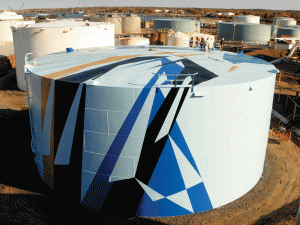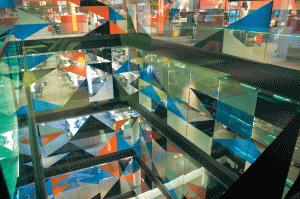« Features
CONSTRUCTIVIST JUNGLE / INTERVIEW WITH JAIME GILI

Jaime Gili, Bill at Pittier, 2009. Exhibition at Kunsthalle Winterthur with Gran Salazar (left) and Yemaya (right). Courtesy Kunsthalle Winterthur.
Jaime Gili (*1972 in Caracas, lives and works in London) is known for his large-scale acrylic paintings that show geometrical forms in truly explosive compositions; an intricate mesh of forms and colors catches the spectator’s attention and draws it into the paintings or, on the contrary, with a dynamic impulse launches it beyond the artworks’ boundaries. Within the thicket of artificially designed surroundings and wallpapers, his large-scale paintings are integral parts, but at the same time they stand out as solitary and autonomous objects. Jaime Gili seems to combine the wilderness of the jungle with a formalist and reductionist artistic language; the result is a kind of Gesamtkunstwerk, a crystalline pulsating organism that almost comes alive.
By Oliver Kielmayer
FROM VENEZUELA TO EUROPE AND BACK
Oliver Kielmayer - Tell me about the very beginnings of your artistic career. What was your background and how were the conditions then in Venezuela?
Jaime Gili - At that time there was no faculty of fine arts. People who wanted to become artists would traditionally study architecture or art history, or they went to a governmental school of art, which was a bit old fashioned. But there were also schools for graphic design. In 1989 I went to one that had teachers from different disciplines: architecture, painting, sculpture. When my family decided to go to Barcelona - where they originally came from - I told the director about the opportunity I had and he said: “What are you still doing here? Go!” When I went to the design faculty at the university in Barcelona I was very disappointed; however, I realized that I didn’t want to become a graphic designer but a painter. I wanted to set my own rules. After a few years, having been offered a grant for the Royal College, I moved to London in 1996.
O.K. - What did your first paintings look like? Were they totally different from what you are doing now?
J.G. - They looked totally different. In Venezuelan painting there is a strong abstract, optical and constructivist tradition, and in Barcelona I hadn’t yet recognized my “South Americanity,” even at the Royal College. I only started later to go deeper into abstraction.
O.K. - Tell me more about the reference to the Venezuelan painting tradition.
J.G. -The art of the 1950s was especially important for me. Abstraction was an international movement then, but in big South American cities there were many particular scenes. Even today the look of Venezuela owes much to the 1950s and painters like Soto, Otero, and Cruz-Diez. Their way of seeing became a general and popular thing and you can see this even now: the way people paint their houses, the way they paint the buses … This popular visual culture is an important source for me, more so than Soto, Otero or Cruz-Diez directly. My visual reference is not so much an intellectual, art-historic one, but much more one based on popular visual culture. When I became conscious of this background, I suddenly felt in place and from there I could decide where to go next.
ABSTRACTION, MODERNISM AND THE SOCIAL CONTEXT
O.K. - In Europe, the 1950s were a time of economic growth and prosperity; most people were happy with life. Nowadays life has become difficult again. The references you mentioned are more of a formal and aesthetic kind and I wonder how this kind of visual language fits into contemporary life. Another example is World War I, when abstraction was big for the first time. I keep on asking myself how you can celebrate abstraction and aesthetic formalism when the world is on fire.
J.G. - For me it’s all linked to a positive and optimistic kind of thinking. It’s not the idea that you sit in your studio and don’t look at the world, but that you offer a happier alternative to what is going on.
O.K. - In literature there was a similar movement, based on the fact that traditional language is just not capable of accurately describing the nightmare called reality anymore. Maybe this can be transferred into visual language, meaning no picture of reality can possibly show the horror of the modern world.
J.G. - That’s an interesting possibility. Things can always be better. In the early fifties most of the infrastructure in Venezuela was built, and in 1958 Venezuela became a democracy and conditions have improved only a little since then. Recently, destruction seems to be the law. Maybe I’m looking at better times, times of creation.
O.K. - What do you think about the current revival of abstract and modernist traditions in contemporary art? Is it based on the need for more sincerity and intellectuality or is it just the art circus being fed up with the banality of real life references?
J.G. - You can always find artists who follow a certain tradition, even if it is not so visible for a time and only concentrated in certain countries.
O.K. - Have you ever been tempted to paint in a naturalistic manner?
J.G. - Oh yes, sometimes I feel the need to reproduce reality. I often reproduce images from the newspaper in watercolor on paper, only in a small size. But it’s more of an exercise; I would never show these works.
THE SLOW MEDIUM CALLED PAINTING
O.K. - Let’s talk a bit about the painting process. How do you begin and how does the work develop?
J.G. - I almost all the time start with an idea from a previous painting; there is always something I want to work out. It can be a shade of brown that I find difficult to deal with or a part of the painting that is astonishing. I also prepare the canvas and prime it myself; to me this is part of the work, and I work on several paintings at the same time.
O.K. - How has your work developed over the last decade?
J.G. - Formally it is quite clear: The first paintings of the current series started with simple star shape, a graphic representation of what a star is. The beginnings were different overlapping star shapes in black and white. Then color got complex; the stars became pointier, and then they started to go beyond the limits of the frame, and now I seem to be concentrating on what’s going on in the middle. I don’t know where it’s leading me next, but it’s been going on for 8 years now.
O.K. - It’s pretty amazing that you stuck to your very particular way of painting over such a long time. Abstract painting was not very hip for a long time, but you seem to be quite immune to fashions and trends.
J.G. - If you take painting seriously, it is a very slow medium. It’s full of little processes and decisions that may look stupid from the outside, but you must go through them, and this is time consuming.
EXPANDED PAINTING
O.K. - You always arrange your paintings into a very particular spatial arrangement; also, you prefer to place them on a wall painting or wallpaper also designed by you. Where do you position yourself in the tradition of expanded painting?
J.G. - Well sometimes things that are labeled expanded painting are not … Maybe I should try to expand expanded painting in such a way that nobody else will be able to use the label of expanded painting anymore! But honestly, for me it’s all about the struggle with space; I always have to fight it. The space can have a lot of character, but still I have to make it mine. I have this urge to make every single corner and every little detail, window and ceiling part of my work. Ideally the painting doesn’t stop at the end of the canvas but goes further into the space, into architecture…
O.K. - So you must like to do art in public space on a large scale. Maybe you should work together with Zaha Hadid?
J.G. - No, she does curves; I don’t do curvy things! But yes, I would love to build houses or whole parts of a city. Look at the “Ciudad Universitaria” in Venezuela: Villanueva, the architect, worked together with artists such as Vasarely, Arp, Calder, and many local ones, and considered their proposals before he actually designed his plans. I don’t see a reason for not going on with this “integration of the arts”; there should be no limit.
O.K. - This brings us to your ongoing project in Portland, Maine; the painting of 16 oil tanks.
J.G. - People who saw the open call told me that it was definitely something for me. Many painters would refuse to paint oil tanks, but I decided to go for it. Well, the restriction of the bright colors like safety red and yellow were upsetting, but in the end I found a good solution with the allowed palette. I created a painting based on the spatial conditions there. Of course it would even be nicer if I didn’t have to stop with the tanks but just go on into the surroundings; the space between the tanks could be linked and one day the whole area could be turned into a park with little painted paths between the tanks; and inside the tanks there could be useful spaces, galleries …

Art all around. Ongoing project for painting 16 tanks in Portland, Maine. Courtesy Georgia Flanagan and Maine Center for Creativity.
O.K. - You like crossing the traditional borders of art. Do you sometimes think about strategies for achieving a more wholesome designing of the world according to your aesthetic standards?
J.G. - I started recently to make more and more contacts with architects. In Venezuela I had the chance to work with some leaders of the opposition who invited me to do bigger projects, from bus designs to a park I am intervening in a very poor neighborhood this year. I’m enjoying this process very much.
O.K. - What is the relation of your work to design? Is it important? Are you conscious of the proximity to some aspects of design and decoration and are you scared of it?
J.G. - I’m not afraid of decoration but perhaps of artists being dragged into mass production. If somebody invites me to do a design for this or that, I tend to be very careful. For example I would be afraid to design a lamp for mass production. It must be the other way round: If somebody asks me to do something for a space and I find I have to design a lamp, it’s fine; vice versa I think is terrifying.
Oliver Kielmayer is director of the Kunsthalle Winterthur and manager of the international artist-in-residence program of the foundation Künstlerhaus Boswil. He co-curated the International Biennial of Contemporary Art (IBCA) in Prague in 2005. Kielmayer is also publisher of the free artist’s newspaper WeAreTheArtists and mentor for students in the master’s degree in curating program at the Zurich University of the Arts.



































